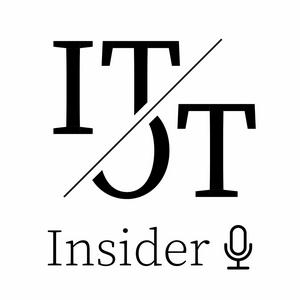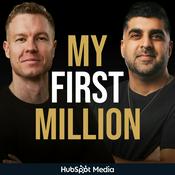The IT/OT Insider Podcast - Pioneers & Pathfinders

41 episodes

When Physics Meets AI: A Conversation with Dan Jeavons
2025/12/02 | 48 mins.
Some guests make you pause halfway through the recording and think, “Okay… this one’s going to need a second listen.”That was the case with Dan Jeavons, president of Applied Computing, formerly VP of Computational Science and Digital Innovation at Shell — and one of the people who has quite literally been shaping how data, AI, and physics come together in industry.From ERP Reports to Foundation ModelsHe began, like so many, somewhere between spreadsheets and SAP.“The biggest value of having an integrated system is the fact that you have an integrated data layer,” he recalls. “I didn’t like the systems much — but the data was really interesting.”That curiosity led him from analytics experiments in R and MATLAB to building Shell’s first Advanced Analytics Center of Excellence — which, as he jokes, “was neither advanced nor excellent… but we got better quickly.”Thirteen years later, he was leading teams across AI, data science, and advanced physics modeling — and wrestling with a problem that every industrial data leader knows too well:“You either rely on physics and trade off flexibility, or you rely on statistics and trade off explainability.”What AI Looks Like From the Plant FloorDan has worked across the energy value chain — from offshore wells to refineries — and says something that surprises many:“From a data perspective, it all looks very similar.”Distributed control systems, process historians… “whether you’re on a platform in the North Sea or in a petrochemicals plant, the data architecture doesn’t really change,” he says.And that’s what makes the AI opportunity so big.If every facility generates data in roughly the same way, then algorithms can be adapted and scaled — not rebuilt from scratch each time.Why IT/OT Convergence Still Hasn’t HappenedAt one point, we asked the question: Has IT/OT convergence really happened?Dan didn’t hesitate:“No. We’re only scratching the surface.”He describes today’s operations as “a DCS at the heart of the operation, surrounded by siloed engineering processes — reliability, maintenance, safety — each with their own tool, using a fraction of the data.”Adding AI layers on top of that, he argues, is helpful but incomplete:“We’ve added a layer of intelligence on top of existing systems. But it hasn’t changed the work process yet.”True convergence, he says, will come when AI doesn’t just analyze the work — it redefines it.The Real Meaning of “Digital Twin”Few topics create more buzz (or confusion) than digital twins. Dan gives one of the clearest definitions we’ve heard:“A true digital twin must do three things: represent the physical world, be interrogable in real time, and run simulations that explain why and what next.”That’s a high bar…“The technology exists,” he says. “We just haven’t stitched it together yet.”Change Management: The Hardest PartDan’s third “impossible problem” isn’t technical — it’s human.“These facilities are extremely risky. They’ve run safely for 40 years. So when you say, ‘Let’s change everything,’ it’s a hard sell.”He lays out the classic resistance:* It works, don’t touch it.* We can’t risk downtime.* We’re here to deliver return on capital, not to experiment.And yet, as he points out:“Even with the way we run things today, we still have reliability problems, we still have safety exposure, and we’re losing expertise fast.”His conclusion is blunt:“Someone is going to figure this out — and when they do, they’ll be 50 % more efficient. If you’re not on that train when it happens… good luck.”Rethinking the Cloud DebateWhen the topic of cloud reliability came up (AWS outages, anyone?), Dan didn’t dodge.“The idea that you’re safe because you’re air-gapped is a fallacy,” he said flatly. “Most OT environments are already virtualized — effectively private clouds. The question isn’t if you’re exposed, it’s how well you manage it.”The challenge, he says, isn’t cyberthreats — it’s change management in the cloud era.“Continuous deployment doesn’t work in operations. We need cloud architectures that respect industrial change control — and OT vendors who step up to modern security standards.”From Use Cases to Foundation ModelsDan’s view of AI’s future is clear: we’re moving from narrow, use-case-specific algorithms to general-purpose foundation models that can reason across disciplines.“Before 2023, companies built algorithms for individual problems: corrosion, valves, compressors. Now, the next generation of models will handle all of them because they understand physics, language, and time series together.”He tells the story of Sam Tukra, his former colleague (now Applied Computing’s co-founder and Chief AI Officer alongside Callum Adamson) who figured out how to make those three domains “talk” to each other.“He built an agentic system that cross-validated physics, language, and time series. I was equal parts proud, frustrated, and amazed. Suddenly, you realize — this is it.”The result is Orbital, their platform that blends these layers — a system that can predict, explain, and reason across disciplines, from reliability to safety to economics.Looking AheadDan calls this convergence of physics and AI an “inflection point for industry.” He’s convinced that in the next decade, the companies who embrace it will operate differently — not because AI tells them what to do, but because it changes how they work.So that means that we need to plan for another podcast in a year or so from now ;)Thanks for listening!Stay Tuned for More!🚀 Join the ITOT.Academy →Subscribe to our podcast and blog to stay updated on the latest trends in Industrial Data, AI, and IT/OT convergence.🚀 See you in the next episode!Youtube: https://www.youtube.com/@TheITOTInsider Apple Podcasts: Spotify Podcasts: Disclaimer: The views and opinions expressed in this interview are those of the interviewee and do not necessarily reflect the official policy or position of The IT/OT Insider. This content is provided for informational purposes only and should not be seen as an endorsement by The IT/OT Insider of any products, services, or strategies discussed. We encourage our readers and listeners to consider the information presented and make their own informed decisions. This is a public episode. If you would like to discuss this with other subscribers or get access to bonus episodes, visit itotinsider.substack.com

Overcoming the Impossible: DataOps at Poclain Hydraulics with Rija Rakotoarisoa
2025/11/25 | 40 mins.
Today’s guest has lived what most companies are still figuring out: how to turn fragmented systems, manual Excel work, and well-intended “shadow IT” into a coherent Industrial DataOps strategy that actually delivers value.In this episode of the IT/OT Insider Podcast, we sat down with Rija Rakotoarisoa, Group IT Operations & Industry 4.0 Lead at Poclain Hydraulics, a French (international) independent group specializing in the design, manufacture and sale of hydrostatic / electrohydraulic transmissions: motors, pumps, valves, system for off-road or mobile machines and one of the global leaders in hydrostatic transmissions.If you’ve ever found yourself trying to bridge IT and OT while juggling standardization, culture change, and budget cuts… you’ll feel very at home in Rija’s story.From Developer to Industry 4.0 LeaderRija started his career firmly on the IT side: a master’s in computer science, developer turned IT manager, working in a plant where his job was to keep systems running and people connected. Then came the shift.“After five or six years, I felt like I had seen everything. I wanted to do something more than pure IT, something that had a direct impact on the business.”So he went back to school, this time for a master’s in finance. Not because he loved accounting, but because it was his way to “remove the geek tag.”“If you wanted to have more impact, you had to speak the business language.”That change paid off. Rija became both IT and finance manager at one of the company’s plants and learned firsthand what happens when you put technology in service of the business. He used automation to help teams understand their own costs, improve efficiency, and cut the manual data entry that was eating up hours every day.Lessons from Good and Bad ProjectsIn his later roles, including a global Industry 4.0 function, Rija saw dozens of digital projects across multiple plants. Some brilliant, others not so much.“A bad example is when a company rolls out something top-down. They say, ‘This is the strategy, you must implement it,’ without asking the real problems at the plant. It takes time, money, and in the end, nobody uses it.”Sound familiar?The good examples, he says, start from the other direction. From real operational pain points.“When you address the real problem in manufacturing - something that changes the day-to-day of the operational team - then they support you, they use it, and they apply it every day.”It sounds simple, but as he adds, “it’s not.” It takes change management, communication, and people inside each plant who carry the message and help build local momentum.Starting from a Digital GreenfieldWhen Rija joined Poclain Hydraulics, about 6 years ago, it was, as he puts it, “a digital greenfield.” The company had strong IT foundations (infrastructure, networks, ERP), but no consistent support for manufacturing systems yet.“There were many IT/OT projects managed only by operational people. They cared about the end result, but not the implications in term of IT constraints. In the end, you have a big nightmare.”In other words: well-intentioned local initiatives, zero standardization. The kind of environment where every plant has its own version of the truth.So where do you start when the elephant is that big?“We started with the most painful issue: the end-of-line quality control system. Each plant had its own version. We moved from local executable applications to a web-based, centralized one.”Then came work instructions, and so on and so on. It was a classic “bite-by-bite” transformation.How COVID Changed the GameLike many others, Poclain had big plans for a global MES rollout. And then COVID hit. Budgets froze, priorities shifted, and suddenly the grand plan was off the table.“We had to rethink everything. How can we do more with less? How can we use what we already have?”What followed was a shift from “big system thinking” to a more agile, best-of-breed approach.“I always say it’s not a happy event for everyone, but I thank COVID-19,” he laughs. “It forced us to be creative.”That creativity led to the Data Hub project: a pragmatic approach to connecting existing systems, automating data collection, and building live dashboards that operators could actually use.Building a DataOps MindsetThe guiding principle was simple: make data useful, make it live, and make it easy for non-IT users.“I didn’t want my team to be the bottleneck. The system should be usable by non-IT people.”That requirement drove their vendor evaluation which eventually led to selecting Litmus.io as their main Data Hub platform.“Since 2021, we’ve been implementing Litmus as our main data hub. Step by step, we break the silos and build on it.”But technology was only one part of the story. The harder part was governance and culture.“It took a lot of time to explain to top management that the Data Hub is just an enabler. It’s not magic. You need something meaningful for the people at the plants on top of it.”Standardization Without Killing FlexibilityToday, Poclain’s model combines global consistency with local agility.“We master the data model centrally and duplicate it for each site. Plants can adapt the templates locally by defining their equipments and their mappings, but the core remains the same.”The result?Faster rollouts, cleaner data, and dashboards that update automatically without anyone touching Excel.Rija’s model proves that digital transformation doesn’t have to mean disruption, just the right balance between structure and freedom, one data point at a time.Interested in knowing more about Litmus? A few months ago we published our 5 Step Playbook for a Painless DataOps Rollout:And have you already listened to our Industrial DataOps podcast with John Younes?Stay Tuned for More!🚀 Join the ITOT.Academy →Subscribe to our podcast and blog to stay updated on the latest trends in Industrial Data, AI, and IT/OT convergence.🚀 See you in the next episode!Youtube: https://www.youtube.com/@TheITOTInsider Apple Podcasts:Spotify Podcasts:Disclaimer: The views and opinions expressed in this interview are those of the interviewee and do not necessarily reflect the official policy or position of The IT/OT Insider. This content is provided for informational purposes only and should not be seen as an endorsement by The IT/OT Insider of any products, services, or strategies discussed. We encourage our readers and listeners to consider the information presented and make their own informed decisions. This is a public episode. If you would like to discuss this with other subscribers or get access to bonus episodes, visit itotinsider.substack.com

From 4 to 140: What Building Northvolt’s Digital Core Taught Anton Melander About Scaling and Starting Over
2025/10/14 | 31 mins.
📣 A quick reminder before we start: Our next ITOT.Academy kicks off on January 23, and our early bird offer is still available. Do you want to join our third group and learn how to bridge IT and OT? There is no better time than now! 👉 Check the curriculum on ITOT.Academy or in this previous article.When Anton Melander joined Northvolt in 2018, the company had around 100 employees and zero factories. The goal? Build Europe’s first large-scale lithium-ion battery production from scratch — and do it fast.“When I joined, there was nothing. I joined the digitalization department, which at the time was me and three others,” Anton told us. “We knew making batteries was fast — really fast — and with tight tolerances. Even microns of misalignment could lead to short circuits. So we wanted to be as data-driven as possible when scaling production.”From that tiny team, Northvolt’s digitalization function grew to over 140 people, while the company itself ballooned to 5,000 employees. It’s a rare story (and one that ended too soon, after Northvolt’s bankruptcy earlier this year). But in those years, Anton learned what it truly means to build an OT organization from nothing, and why many of those lessons are now shaping his next chapter as a startup founder.Thanks for reading The IT/OT Insider! Subscribe for free to receive new posts and support our work.Greenfield DecisionsNorthvolt’s early advantage was also its biggest challenge: a completely blank slate.“We had to figure out what to build and what to buy,” Anton said. “Off-the-shelf software meant long requirement lists, consultants, and change orders. Building in-house gave us flexibility, but it also meant taking full ownership.”At the time, OPC UA was only beginning to gain traction. Northvolt pushed its equipment suppliers to provide compliant servers and built its own IoT platform to handle the data. “We provisioned over a thousand gateways,” Anton recalled. “Just setting that up was a project in itself.”That internal platform became the backbone of production — the foundation of what they later called North Cloud, an internal MES connecting operations, quality, and material flow. “We built a lot ourselves,” Anton said, “but we still leveraged AWS for the cloud, and bought things like ERP and PLM. It was a mix, but a deliberate one.”From Projects to ProductsAs production ramped up, the company’s digital organization had to evolve.“In the beginning, we were completely project-based,” Anton explained. “But as production started, we realized that technology is one thing — it’s only useful if it actually helps people do their job. So we moved from a project-oriented way of working into a product-oriented one.”That shift (which many IT/OT teams wrestle with) required a mindset change. “Everyone wants their feature,” he said. “The backlog keeps growing forever. But not everything that sounds important actually moves the needle. You need to tie initiatives to measurable results: quality, throughput, yield.”He laughs looking back. “Sometimes senior stakeholders would say, ‘This is the most important thing,’ and you had to tell them: ‘It’s not going to increase throughput or quality.’ That’s the hard part.”His other big lesson? Master data. “You can’t calculate OEE if you don’t know the ideal cycle time. You can’t calculate downtime if you don’t know the planned uptime. It’s easy to draw perfect architecture diagrams, it’s harder to make them work in practice.”What Comes After NorthvoltAnton left Northvolt in 2023, before its final collapse, but the experience left him with two realizations: first, that building your own tech stack is both empowering and costly and second, that most manufacturers will never have that luxury.“More than 90 percent of manufacturing companies have fewer than 200 employees,” he said. “They can’t hire 140 people to build their own MES or IoT platform. And yet, they still need data.”That insight became the starting point for his new company, Ronja, which focuses on helping small and mid-sized manufacturers make sense of the data they already have.“We’ve spoken to more than 300 manufacturers since we started,” Anton told us. “Almost all of them say the same thing: they have lots of data, but they’re not using it. The problem isn’t collecting data, it’s getting value out of it.”Ronja’s approach isn’t to replace systems, but to sit on top of what exists, making data accessible to non-technical users. “In most factories,” he said, “data lives in Excel, in emails, in historians. We help people connect it, visualize it, and analyze it faster — without waiting for a two-year MES rollout that eats the entire budget.”Closing ThoughtsNorthvolt’s story is one of ambition and hard-earned lessons: a company that built everything from scratch, scaled fast, and still couldn’t outrun industrial reality. But its alumni, like Anton, carry those lessons forward.His takeaway applies to anyone working on digital transformation, from startups to global enterprises:“The closer you are to the shopfloor, the more unique every factory becomes. You can’t standardize everything — but you can make it easier to understand, to learn, and to improve.”And that, ultimately, is what industrial digitalization has always been about.Stay Tuned for More!🚀 Join the ITOT.Academy →Subscribe to our podcast and blog to stay updated on the latest trends in Industrial Data, AI, and IT/OT convergence.🚀 See you in the next episode!Youtube: https://www.youtube.com/@TheITOTInsider Apple Podcasts: Spotify Podcasts: Disclaimer: The views and opinions expressed in this interview are those of the interviewee and do not necessarily reflect the official policy or position of The IT/OT Insider. This content is provided for informational purposes only and should not be seen as an endorsement by The IT/OT Insider of any products, services, or strategies discussed. We encourage our readers and listeners to consider the information presented and make their own informed decisions. This is a public episode. If you would like to discuss this with other subscribers or get access to bonus episodes, visit itotinsider.substack.com

Industrial Data and AI through the eyes of an End-User – A Conversation with Nathalie Rigouts
2025/9/30 | 33 mins.
In our earlier articles, we laid the groundwork for Industrial AI — breaking down the difference between classic AI, generative AI, and agentic AI. But frameworks alone don’t tell the full story. How do these ideas play out when you’re inside a real industrial company, tasked with building teams, getting budget, and making data actually deliver value?For that perspective, we sat down with Nathalie Rigouts, who until recently headed data and analytics at Borealis and is now Head of Business Applications Data and AI at Umicore. Nathalie brings a refreshing, pragmatic voice — someone who moved from finance into IT, and who knows first-hand the reality of building data capabilities in industry.From Finance to Data & AINathalie didn’t start in IT. Her background is in finance, where every month she wrestled with massive spreadsheets just to get accurate actuals. That pain, she recalls, was the start of her data journey:“Every month again, I was struggling with getting the correct actuals. And then of course, you have to make your forecast.”From implementing a financial planning tool, to establishing BI at Borealis, to eventually leading data and analytics, her path shows how close the link is between business need and IT capability. And she’s clear about the lesson: it’s not about technology for its own sake.“It’s not about implementing Microsoft Copilot. You’re not going to gain any sustainable advantage there. But if you can have a deep understanding of the processes in your company, and where data-driven solutions can help, that’s when you start to create value.”Start Small, Sell the SuccessOne of the recurring themes in Nathalie’s story is pragmatism. At Borealis, the team started in 2016 with literally one data scientist and a laptop. “Python notebooks on a laptop, and we started.”The key, she says, is to find enthusiastic allies and solve problems that matter. And once you do, don’t stay modest: market the success internally.“We often forget to sell our success. I would go everywhere and talk about small things we did. And that’s how you gain support for the next steps.”From that first laptop, the team grew, but only because each step came with visible, tangible wins that created pull from the business.Use Cases That MatterSo what are typical use cases in manufacturing? Nathalie sees three common ones:* Predictive maintenance: “If equipment fails often, anomaly detection and predictive maintenance are obvious first steps. But it’s not an easy nut to crack. Often, you don’t have enough failures to feed a model.”* Quality control with computer vision: mainstream, but effective. With enough annotated pictures, good vs bad quality can be classified quickly. The catch? Data Quality.* Logistics optimization: untangling shipping routes and optimizing delivery to customers with AI-based optimization models.These are concrete, valuable problems — and they also highlight the role of data governance. As she recalls with a smile:“We had beautifully annotated data — but all in Finnish. That’s when you realize governance is not optional.”GenAI: Efficiency or Attractiveness?When it comes to Generative AI, Nathalie is cautious. The business case is not always straightforward:“I tried to make the case for Microsoft Copilot. At €30 per user, that’s not small. Does it reduce workforce? No. At best, people spend more time on value-added activities. But what does that bring to the bottom line? Hard to say.”Yet she also sees why companies can’t ignore it.“Companies have to invest in it because it will determine their attractiveness as an employer. New graduates take these tools for granted. If you don’t offer them, you won’t attract talent.”She distinguishes between two levels: workplace efficiency (nice, but hard to quantify) and domain-specific models trained on your own IP. The latter, she believes, is where the real value lies. For example in pharma, where LLMs trained on internal knowledge can speed up R&D. “That’s when AI becomes a true digital co-worker.”Governance, Change, and LegislationOn governance, Nathalie doesn’t mince words:“It’s always the people, the processes, and the tools. The main component around which all of them center is the value case.”Her advice: don’t let your solutions depend on a single enthusiast, and don’t leave an escape hatch back to the old way of working. Change management is part of the job.And on legislation, she takes a positive view:“It’s an opportunity. It forces us to think about awareness, ethics, governance, documentation, monitoring. All things that make sense. Yes, it’s work, but it helps you get budget and build maturity.”Closing ThoughtsWhat we loved about Nathalie’s perspective is how grounded it is. No buzzwords, no silver bullets: just the reality of building teams, solving problems, and learning along the way. Whether it’s predictive maintenance, quality monitoring, or navigating the GenAI hype.Her closing reminder:“Keep it simple, be pragmatic. We built beautiful solutions with just scripting business rules. The business was happy, and nobody needed a fancy machine learning model.”Stay Tuned for More!🚀 Join the ITOT.Academy →Subscribe to our podcast and blog to stay updated on the latest trends in Industrial Data, AI, and IT/OT convergence.🚀 See you in the next episode!Youtube: https://www.youtube.com/@TheITOTInsider Apple Podcasts: Spotify Podcasts: Disclaimer: The views and opinions expressed in this interview are those of the interviewee and do not necessarily reflect the official policy or position of The IT/OT Insider. This content is provided for informational purposes only and should not be seen as an endorsement by The IT/OT Insider of any products, services, or strategies discussed. We encourage our readers and listeners to consider the information presented and make their own informed decisions. This is a public episode. If you would like to discuss this with other subscribers or get access to bonus episodes, visit itotinsider.substack.com

MQTT vs OPC UA with Kudzai Manditereza
2025/9/02 | 35 mins.
When we talk about industrial connectivity, two names always come up: OPC UA and MQTT. They’re often mentioned in the same breath, as if they’re competitors. But as Kudzai Manditereza reminded us in our conversation, that’s a bit of a misconception. These protocols solve different problems, and understanding their history helps explain why they’re both so important today.OPC UA: From Printer Drivers to Industrial StandardsThe story of OPC goes back to the 1990s. At the time, every automation vendor shipped their own drivers, making integration a nightmare. The OPC Foundation stepped in to create a standardized interface — inspired, of all things, by Microsoft’s printer driver model. Just as Windows could talk to any printer through a standard interface, OPC offered a way for SCADA systems and historians to talk to PLCs without custom drivers.Thanks for reading The IT/OT Insider! Subscribe for free to receive our weekly articles directly in your mailbox!The first generation, known as OPC Classic (DA/HDA), was Windows-only and limited in scope. It solved the immediate problem but couldn’t handle the growing complexity of industrial data. Enter OPC UA (Unified Architecture): cross-platform, internet-capable, and built with powerful information modeling.This is where OPC really shines. As Kudzai put it:“The shop floor is full of objects — pumps, compressors, machines. OPC UA lets you model those objects, not just pass around raw tags.”That means a machine builder can ship a unit with a pre-built OPC UA information model, ready for plug-and-play integration.The OPC Foundation even created companion specifications for different industries, so a compressor in Germany “speaks” the same OPC language as a compressor in the US. No more reinventing interfaces for every project.MQTT: Born in the Oil Fields, Adopted by the InternetIf OPC UA came from printer drivers, MQTT came from oil pipelines (well… actually from the even older pub-sub newsgroups back when the internet was still something really special).In 1999, IBM engineers developed MQTT to monitor pipelines over unreliable, low-bandwidth satellite links. The key innovation was the publish/subscribe model: instead of clients constantly polling servers for updates, devices publish data to a central broker, and anyone interested can subscribe.This lightweight, bandwidth-efficient design made MQTT perfect for remote monitoring. But it didn’t stay confined to industry. In fact, one of its biggest early adopters was Facebook, who used MQTT in their Messenger platform. By the 2010s, MQTT had made its way back to industry, now riding the wave of IIoT and event-driven architectures.As Kudzai explained:“MQTT doesn’t tell you how to model your data. It’s a transport protocol. But its hierarchical topic structure maps naturally to concepts like the Unified Namespace (UNS).”Think of it like a Google Drive folder structure: data is organized into topics, and anyone can subscribe to the parts they care about.OPC UA vs MQTT: Different Tools, Different JobsSo should you pick OPC UA or MQTT? The answer is: both, but for different layers.* OPC UA excels close to the machines (Levels 0–2 in the Purdue Model). It provides a rich, standardized way to model and expose machine data. Perfect for SCADA, DCS, and local control.* MQTT shines at higher levels (L3/DMZ and above). It’s ideal for integrating thousands of devices into enterprise systems, feeding data lakes, or enabling event-driven architectures. And of course also for IIoT devices spread around the world!As Kudzai put it:“You’ll never control a pump with MQTT. But if you want to share events across your enterprise (machine status, recipes, quality data,…) MQTT is a great fit.”And that’s an important distinction. OPC UA is about structured access to objects. MQTT is about lightweight distribution of events. They don’t replace each other — they complement each other.Closing ThoughtsIndustrial connectivity isn’t about choosing one protocol over the other. It’s about using the right tool for the job. OPC UA and MQTT are part of the same toolbox — and when used together, they unlock scalable, reusable, event-driven architectures that finally let IT and OT speak the same language.As Kudzai summed it up:“The ability to reuse data is a huge factor. Once you stop thinking point-to-point and start thinking platform, that’s when scale happens.”… And we couldn't agree more!Also, take a look what HiveMQ has to offer: Stay Tuned for More!🚀 Join the ITOT.Academy →Subscribe to our podcast and blog to stay updated on the latest trends in Industrial Data, AI, and IT/OT convergence.🚀 See you in the next episode!Youtube: https://www.youtube.com/@TheITOTInsider Apple Podcasts: Spotify Podcasts: Disclaimer: The views and opinions expressed in this interview are those of the interviewee and do not necessarily reflect the official policy or position of The IT/OT Insider. This content is provided for informational purposes only and should not be seen as an endorsement by The IT/OT Insider of any products, services, or strategies discussed. We encourage our readers and listeners to consider the information presented and make their own informed decisions. This is a public episode. If you would like to discuss this with other subscribers or get access to bonus episodes, visit itotinsider.substack.com
More Business podcasts
Trending Business podcasts
About The IT/OT Insider Podcast - Pioneers & Pathfinders
Listen to The IT/OT Insider Podcast - Pioneers & Pathfinders, Founders and many other podcasts from around the world with the radio.net app

Get the free radio.net app
- Stations and podcasts to bookmark
- Stream via Wi-Fi or Bluetooth
- Supports Carplay & Android Auto
- Many other app features
Get the free radio.net app
- Stations and podcasts to bookmark
- Stream via Wi-Fi or Bluetooth
- Supports Carplay & Android Auto
- Many other app features


The IT/OT Insider Podcast - Pioneers & Pathfinders
download the app,
start listening.





































